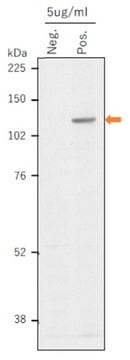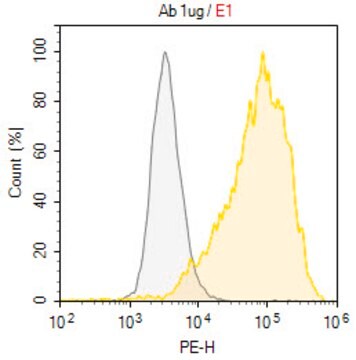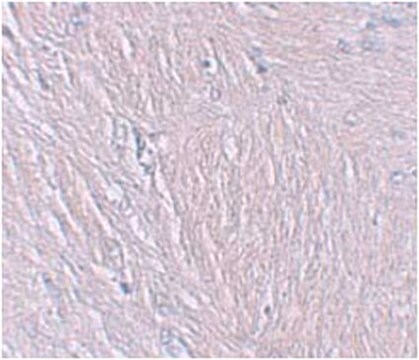MABC1795
Anti-phospho-TERT (Thr249) Antibody, clone TpMab-3
Sinônimo(s):
EC:2.7.7.49, HEST2, TP2, Telomerase catalytic subunit, Telomerase reverse transcriptase, Telomerase-associated protein 2
About This Item
Produtos recomendados
fonte biológica
mouse
Nível de qualidade
forma do anticorpo
purified antibody
tipo de produto de anticorpo
primary antibodies
clone
TpMab-3, monoclonal
peso molecular
calculated mol wt 127 kDa
observed mol wt ~127 kDa
purificado por
using protein G
reatividade de espécies
human
embalagem
antibody small pack of 100
técnica(s)
immunofluorescence: suitable
immunohistochemistry: suitable
western blot: suitable
Isotipo
IgG1κ
sequência de epítopo
N-terminal half
nº de adesão de ID de proteína
nº de adesão UniProt
temperatura de armazenamento
2-8°C
Informações sobre genes
human ... TERT(7015)
Especificidade
Imunogênio
Aplicação
Isotype testing: Identity confirmation by Isotyping Test.
Isotyping Analysis: The identity of this monoclonal antibody is confirmed by isotyping test to be mouse IgG1k.
Tested Applications
Immunofluorescence Analysis: A representative lot detected TERT in Immunofluorescence applications (Matsuda, Y., et al. (2022). J Pathol. 257(2):172-185).
Western Blotting Analysis: A 1:250 dilution from a representative lot detected TERT in Mitotic HeLa cells with RO3306 treatment (negative) versus mitotic HeLa cell samples (positive), where the positive control samples were obtained by IP using clone 10E9-2 to enrich hTERT ( Data courtesy of Dr. Kenkichi Masutomi, National Cancer Center Research Institute, Tokyo, Japan).
Western Blotting Analysis: A representative lot detected TERT in Western Blotting applications (Matsuda, Y., et al. (2022). J Pathol. 257(2):172-185).
Immunohistochemistry Applications: A representative lot detected TERT in Immunohistochemistry applications (Matsuda, Y., et al. (2022). J Pathol. 257(2):172-185).
Note: Actual optimal working dilutions must be determined by end user as specimens, and experimental conditions may vary with the end user.
Descrição-alvo
forma física
Reconstituição
Armazenamento e estabilidade
Outras notas
Exoneração de responsabilidade
Not finding the right product?
Try our Ferramenta de seleção de produtos.
Código de classe de armazenamento
12 - Non Combustible Liquids
Classe de risco de água (WGK)
WGK 1
Ponto de fulgor (°F)
Not applicable
Ponto de fulgor (°C)
Not applicable
Certificados de análise (COA)
Busque Certificados de análise (COA) digitando o Número do Lote do produto. Os números de lote e remessa podem ser encontrados no rótulo de um produto após a palavra “Lot” ou “Batch”.
Já possui este produto?
Encontre a documentação dos produtos que você adquiriu recentemente na biblioteca de documentos.
Nossa equipe de cientistas tem experiência em todas as áreas de pesquisa, incluindo Life Sciences, ciência de materiais, síntese química, cromatografia, química analítica e muitas outras.
Entre em contato com a assistência técnica








